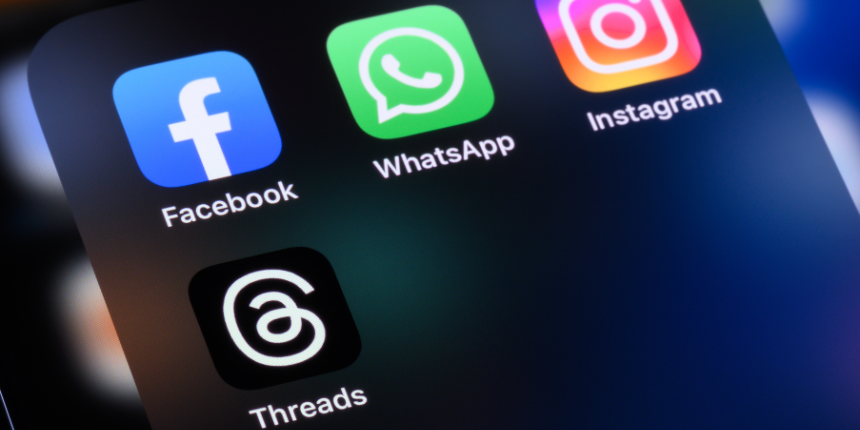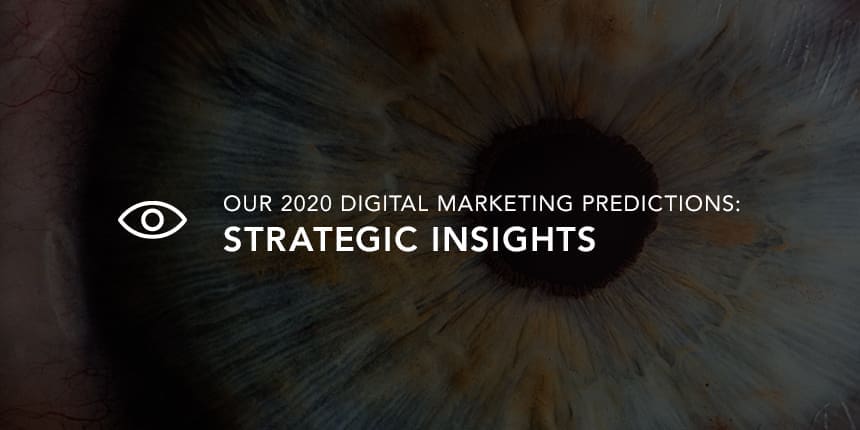
Amplify your reach and drive results with our tailored paid media strategies.

Our Strategic Insights practice is all about using data to forecast trends. So, we’re only too happy to dust off our trusty crystal ball to predict what’s coming—and what marketers should be paying attention to—in the year 2020. Here are the top five trends that are shaking things up as we kick off a new decade.
Tired of hearing about millennials? A new generation is waiting in the wings. Here’s what you need to know about this up-and-coming cohort who will soon be dominating our share of attention—and share of wallet.
“Generation Z” is broadly defined as those born between 1997 and 2012. They’re sometimes referred to as post-millennials, iGen, or some as-yet-to-be-defined name. In other words, they are today’s pre-teens, teens, and just-graduating young adults. As the millennial generation settles into home ownership and parenthood, GenZ are coming up. They’re the ones now driving trends in everything from fashion to music, pop culture, and social media.
And there are a lot of them: they comprise 32% of the world’s population. By January, they will make up a whopping 40% of all US consumers, influencing over $600 billion in family spending.
So, what do we know about them? They are the most ethnically diverse generation in history. They never knew a time before the Internet, and technology has always been a part of their lives. They value authenticity over the curated, carefully crafted images put forth by millennials on social media. They are heavy users of Instagram, YouTube, and Snapchat, and are driving the rapid rise in relatively new platforms like TikTok and VSCO.
We’re only starting to understand GenZ and the impact that they will have on marketing and spending. But the memo to marketers is that they’re the new game in town. Ignore them at your peril.
We’re always circumspect about buzzwords—and that’s exactly what “omnichannel” was when it began appearing just about everywhere in this decade. The idea behind it wasn’t bad. Marketers were finally acknowledging that consumers interact with their brands in more than one channel, and that they needed to start crafting integrated strategies.
The problem was in the execution. Marketers continued to plan ads for mass digital, print, out-of-home, and in-store channels in separate silos. As the number of channels grew, achieving the perfect integration became overwhelming for most resource-strapped companies, who often cut back on certain channels as a result.

But we’ve started to recognize how inward-looking this whole idea was. After all, customers don’t distinguish between (or even notice) their multi-platform, multi-channel behavior. They only notice the failings when a brand experience in one channel feels glaringly inconsistent from the rest.
In 2020, we’ll be talking less about “omnichannel” in the literal sense. In fact, we’ll stop caring so much about channels at all. Instead, we will shift entirely to understanding our customer—their wants, needs, behavior, and identity—and we’ll look to reach them with the right story and messaging wherever they happen to be, allowing them to drive the choice of media through their own activities.
Ultimately, we’ll be talking about the customer, not the channel, flipping the old adage on its head: the customer—not the media—is the message.
Last decade was all about people’s excitement monetizing big data. By some measures, 90% of all the data in the world was created in the past two years—and by January 2020, it’s estimated that 1.7MB of data will be created every second for every person on earth.
We’ve hit peak data overload. But we’ve been remiss in thinking about how to use it judiciously and responsibly. Cambridge Analytica was just the tip of the iceberg; with data breaches being reported in the news almost weekly—and debates raging about the societal impacts of targeted advertising in everything from politics to hiring—marketers are less worried about how to profit from user data, and more about how to avoid the whole thing blowing up in their faces.
In the 2020s, marketers will prioritize figuring out how to collect and use data in a more transparent and responsible way. We will likely see more government and international regulation, more political discussion about data privacy, and more stringent rules on how to collect, store, and use personal data. Marketers can get ahead of this trend by implementing their own privacy and security policies and clearly communicating them to their audiences.
Subscribe to our monthly newsletter.
We enter 2020 in a highly charged political atmosphere, where every marketing, purchase, and advertising decision has a subtext. Millennials are boycotting brands they feel are unaligned with their values, while GenZ is even more tuned in, making ethical business practices a prerequisite rather than an afterthought.
Brands that enter into the debate in a lukewarm fashion—from the environment to diversity and representation—are learning that virtue signaling can backfire if you have nothing to back it up with. Too often, campaigns come across as insincere, tone deaf, hypocritical, or simply unsubstantiated.

As a result, many brands are excusing themselves from partaking—only to find themselves unwittingly dragged into the crossfire when an ill-timed tweet or an unfortunate news story emerges. The smart ones get ahead of it with a strategy from the get-go, but these strategies only work when they are based on legitimate values held by the company’s owners, management, and staff.
In the next decade, brands won’t be able to choose to be neutral. Opting out is no longer an option.
Last week, my somewhat technologically challenged baby boomer mother told me she was taking an artificial intelligence course at the local seniors’ center. I took this as a sign: AI has exited the realm of science fiction and futurism and has officially entered the mainstream.
Many people don’t even realize to what degree AI has already entered their lives. From diagnostic robots in the healthcare realm to in-home personal assistants like Google Home or Alexa to robo-advisors in the personal finance and investment world, we’re already using machine learning technology whether we know it or not.
For marketers, the practical possibilities of AI are manifold. From chatbots to predictive algorithms for media optimization or even inventory management, AI has firmly integrated itself into our homes, businesses, and lives. In 2020, marketers will need to think about how to fully utilize these technologies and how to drive them forward.
Need a partner to take your online efforts to the next level in 2020? Our unique expertise—and equally unique breadth of digital marketing services, from enterprise to local—is at your fingertips. Contact DAC today.
Amplify your reach and drive results with our tailored paid media strategies.
Amplify your reach and drive results with our tailored paid media strategies.
Subscribe to our monthly newsletter.